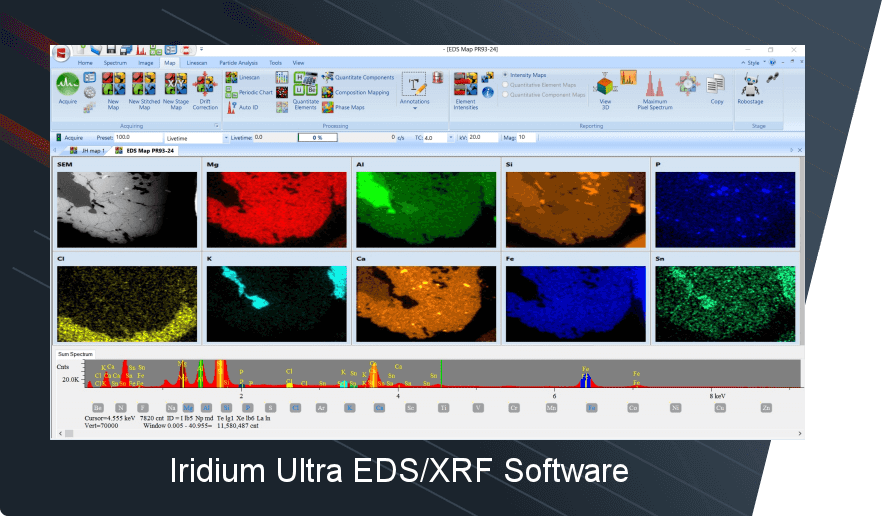Modern botany is a broad, multidisciplinary subject with inputs from most other areas of science and technology. Research topics include the study of plant structure, growth and differentiation, reproduction, biochemistry and primary metabolism, chemical products, development, diseases, evolutionary relationships, systematics, and plant taxonomy. Dominant themes in 21st century plant science are molecular genetics and epigenetics, which are the mechanisms and control of gene expression during differentiation of plant cells and tissues. Botanical research has diverse applications in providing staple foods, materials such as timber, oil, rubber, fibre and drugs, in modern horticulture, agriculture and forestry, plant propagation, breeding and genetic modification, in the synthesis of chemicals and raw materials for construction and energy production, in environmental management, and the maintenance of biodiversity.1
Application Note
Imaging of Trace Metal Uptake by Plants
Application Note
Modern Botany
Reference Paper
Distribution and chemical form of selenium in Neptunia amplexicaulis from Central Queensland, Australia
DOl: 10.1039/C9MT00244H (Paper) Metallomics, 2020, 12, 514-527
by Maggie-Anne Harvey a, Peter D. Erskine a, Hugh H. Harris b, Gillian K. Brown c, Elizabeth A. H. Pilon-Smits d, Lachlan W. Casey e, Guillaume Echevarria f and Antony van der Ent af
a Centre for Mined Land Rehabilitation, Sustainable Minerals Institute, The University of Queensland, Queensland, Australia.
b Department of Chemistry, The University of Adelaide, Australia
c Queensland Herbarium, DES, Toowong, Australia
d Biology Department, Colorado State University, USA
e Centre for Microscopy and Microanalysis, The University of Queensland, Australia
f Universite de Lorraine-INRA, Laboratoire Sols et Environnement, UMR 1120, France
Received 30th September 2019, Accepted 27th January 2020.
First published on 14th February 2020.
ABSTRACT:
Selenium (Se), a trace element essential for human and animal biological processes, is deficient in many agricultural soils. Some extremely rare plants can naturally accumulate extraordinarily high concentrations of Se. The native legume Neptunia amplexicaulis, endemic to a small area near Richmond and Hughenden in Central Queensland, Australia, is one of the strongest Se hyperaccumulators known on Earth, with foliar concentrations in excess of 4000 mg Se g-1 previously recorded. Here, we report on the Se distribution at a whole plant level using laboratory micro X-ray Fluorescence Microscopy (µXRF) and scanning electron microscopy (SEM-EDS), as well as on chemical forms of Se in various tissues using liquid chromatographymass spectrometry (LC-MS) and synchrotron X-ray absorption spectroscopy (XAS). The results show that Se occurs in the forms of methyl-selenocysteine and seleno-methionine in the foliar tissues, with up to 13600 mg Se g-1 total in young leaves. Selenium was found to accumulate primarily in the young leaves, flowers, pods and taproot, with lower concentrations present in the fine-roots and stem and the lowest present in the oldest leaves. Trichomes were not found to accumulate Se. We postulate that Se is (re)distributed in this plant via the phloem from older leaves to newer leaves, using the taproot as the main storage organ. High concentrations of Se in the nodes (pulvini) indicate this structure may play an important a role in Se (re)distribution. The overall pattern of Se distribution was similar in a non-Se tolerant closely related species (Neptunia gracilis), although the prevailing Se concentrations were substantially lower than in N. amplexicaulis.
ATLAS X microEDXRF elemental maps of K, Ca and Se of a hydrated infructescences of Neptunia amplexicaulis
ATLAS X microEDXRF elemental maps of K, Ca and Se of a hydrated mature inflorescence of Neptunia amplexicaulis
References
1 https://en.wikipedia.org/wiki/Botany
Back to Application Note
Looking for a Specific Application Note?
Fill out the form to request an application note. We have many that are instantly available and others we will customize to your needs.







